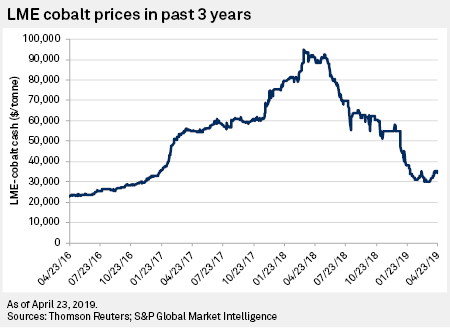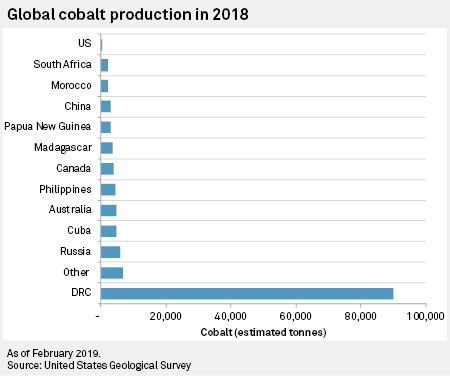With cobalt prices plummeting over the past year after an unexpected glut in supply, analysts said prices need to return to 2018 levels to fund new mines that can meet growing cobalt demand from the electric vehicle sector. But as recent history has shown, even a relatively small mismatch in supply and demand can wreak havoc on prices.
"The industry has to be generating sufficient organic capital to be able to invest and create the supply," said Paul Gait, a Bernstein analyst who follows metals used in the battery market.
"The industry fundamentally is not doing that at the moment. We are in a non-equilibrium condition. We are at a point of suppressed price."
This is happening as electric vehicles make inroads into the traditional automotive sector where pure fossil fuel-powered vehicles still dominate. Global EV sales, including plug-in hybrids, hit 2.2 million units in 2018, according to Bernstein research, almost doubling year over year. If EV sales are still a tiny slice of the overall vehicle market, under 3% in 2018, many analysts expect EVs to grab market share in the coming decade as the technology matures and battery costs fall.
In their models, Bernstein analysts assume EVs penetrate up to 35% of the market by 2030. With that growth comes greater demand for battery metals such as lithium, nickel and cobalt. "By 2030, we see each EV requiring an average of 12 kilograms of lithium, 8 kilograms of cobalt, 46 kilograms of nickel, and 131 kilograms of copper," Gait said in a March research note.
Reflecting already rising demand from the EV sector, the price of cobalt nearly quadrupled between 2016 and early 2018, with spot metal prices on the London Metal Exchange nearing US$100,000/t. But then it reversed course in mid-2018, returning closer to early 2016 levels.

Gait said one reason for the price crash was a spurt of activity from so-called artisanal cobalt miners, which are casual, unregulated side businesses, mostly in the Democratic Republic of the Congo. The extent of additional production from these murkier sources of cobalt in 2018 caught some analysts by surprise, including Gait.
With end users voicing concern about child labor prevalent in the informal sector, Gait said he did not expect the market to accommodate as much of the questionable material as it did. "Pardon my French, but when push came to shov, people were happy to buy artisanal material if it was cheaper," Gait said.
The DRC produces most of the world's cobalt, often as a byproduct from large copper operations, such as Katanga Mining Ltd.'s 75%-owned Kamoto copper-cobalt mine. The DRC is by far the largest cobalt-producing country in the world, with 90,000 tonnes of output in 2018. Russia was the second-highest producer, with 5,900 tonnes, according to data from the U.S. Geological Survey.

Resurgent price
Cobalt prices have picked up in recent weeks, rising to US$35,000/t from about US$30,000/t. Benchmark Minerals analyst Caspar Rawles said speculative traders were driving the bump.
He doubts that the rally has much more steam this year, with the market likely in oversupply. But looking beyond 2019, he and Gait said the price would have to rise substantially to back construction of new mines from which production will be needed to meet demand.
Gait, in modeling expected EV-sector growth in the medium term, expects cobalt prices to rise the most among battery metals: 173% for cobalt, 73% for nickel and 27% for copper. Lithium, on the other hand, was more or less fairly priced, he wrote.
Analysts expect some additional cobalt to come from nickel laterites, a type of weathered ore comprising the majority of global nickel reserves, outside the DRC, with few other major sources to tap. If so, treatment of the ores will require costly high-pressure acid leach processing to capture cobalt. Analysts believe that both nickel and cobalt prices will need to increase for such projects to work.
Regardless of whether funding needs will be met, end users should brace for a roller-coaster price ride. Gait noted cobalt is a thinly traded metal in a modest-sized market with supply dominated by a single country and demand growth dominated by a single source.
"Very small changes in the flow of this material can lead to meaningful changes in the price," Gait said. "It's going to be hideously volatile."



